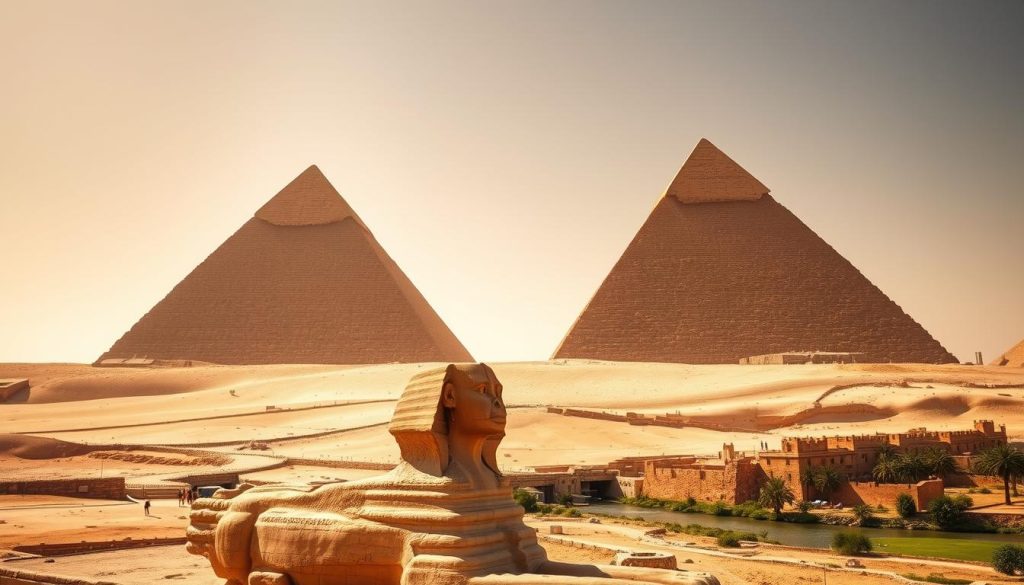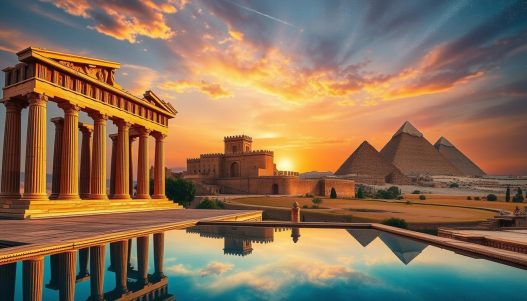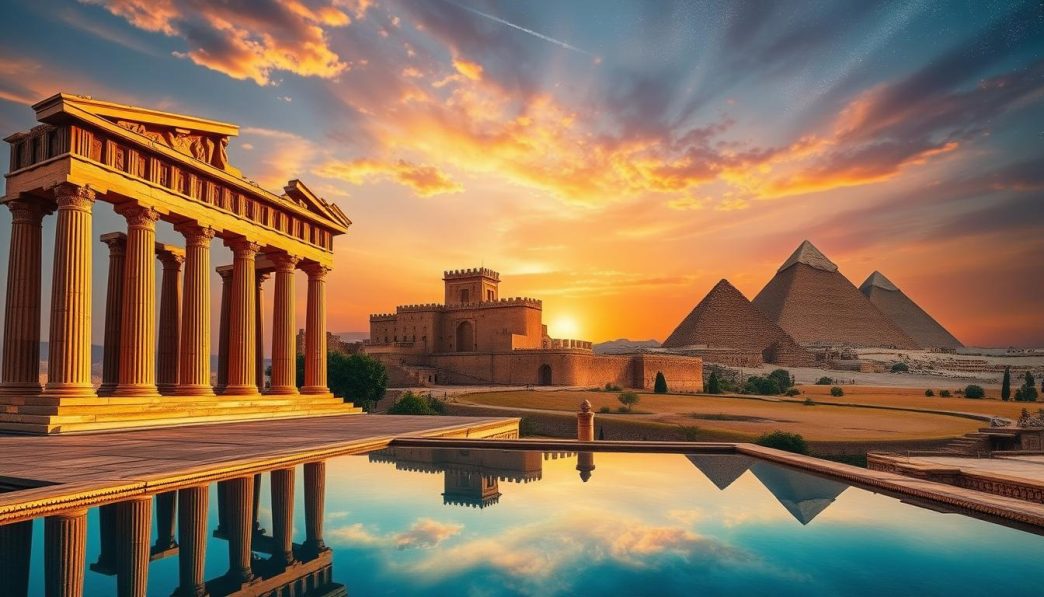Exploring the world’s historical travel sites is like stepping into a time machine. The past comes alive with every step. These cultural heritage sites are not just relics of the past. They are gateways to understanding our shared history.
From the majestic Pyramids of Giza to the ancient ruins of Machu Picchu and the Colosseum, each site offers a unique glimpse into the past. These archaeological sites are more than just tourist attractions. They are testaments to human ingenuity and perseverance.
In this article, we’ll embark on a journey to discover 7 captivating historical travel sites. They promise to enrich your understanding of the world’s diverse cultural heritage.
Key Takeaways
- Discover the world’s most significant historical travel sites.
- Explore the cultural heritage and historical significance of each site.
- Learn about the archaeological importance of these sites.
- Find out how these sites can enrich your travel experiences.
- Get insights into the civilizations that once thrived at these locations.
The Allure of Historical Travel
Historical travel connects us to our past. Historical sites are more than old buildings; they open doors to our cultural heritage. As Nina Berman, a renowned travel writer, once said, “Travel is about experiencing the unfamiliar and learning about the world around us.”
Connecting with Our Past
Visiting historical sites lets us follow in our ancestors’ footsteps. It’s a chance to see, touch, and feel the history that shapes our lives today.
For example, walking through ancient ruins in Greece or Rome is deeply moving. As David Lowenthal, a historian, noted, “The past is a foreign country; they do things differently there.”
The Educational Value of Historical Sites
Historical travel is more than just seeing sights; it’s a learning experience. It offers a hands-on way to learn that textbooks can’t match.
“Travel makes one modest. You see what a tiny place you occupy in the world.” –
This learning aspect of historical travel helps us appreciate history’s complexity and human diversity.
Journeying Through Time: 7 Captivating Historical Travel Sites
Historical travel sites are more than just places to visit. They are keys to understanding our shared history and how societies have changed. These sites mix culture, history, and adventure, attracting travelers globally.
What Makes These Sites Special
Each of the 7 historical travel sites we’ll explore has its own unique charm and importance.
- Architectural Marvels: Sites like the Pyramids of Giza and Petra show incredible engineering and design.
- Historical Significance: Places like the Colosseum and Angkor Wat are filled with history, giving us glimpses into our ancestors’ lives.
- Cultural Impact: Destinations like Machu Picchu and Chichen Itza have become cultural icons.
The Power of Experiencing History Firsthand
Experiencing history firsthand lets travelers connect with the past in a meaningful way.
- Immersive Experience: Exploring ancient ruins can be deeply moving.
- Educational Value: Visiting historical sites connects us to the past in a real way.
Machu Picchu: The Lost City of the Incas
Machu Picchu, known as the ‘Lost City of the Incas,’ is a historical gem. It shows us what life was like for the Inca people. This 15th-century citadel sits in the Andes Mountains of Peru. It proves the Inca civilization’s advanced engineering and architecture.
Historical Significance and Discovery
Machu Picchu is significant because it’s well-preserved. It gives us a peek into Inca culture and daily life. The site was abandoned before the Spanish conquistadors arrived, helping it stay intact.
Hiram Bingham’s Expedition
In 1911, Hiram Bingham’s expedition made Machu Picchu famous. Bingham, an American archaeologist, was guided to the site. His discovery sparked interest in the site, both academically and among the public.
Inca Engineering Marvels
The Incas’ engineering skills are clear in Machu Picchu. The site has sophisticated stonework, with stones fitting together without mortar. They also created agricultural terracing and irrigation systems. These allowed them to farm in the tough mountain terrain.
| Feature | Description | Significance |
|---|---|---|
| Sophisticated Stonework | Stones cut and fitted together without mortar | Demonstrates advanced engineering skills |
| Agricultural Terracing | System of flat plots for cultivation | Allowed for crop cultivation in mountainous terrain |
| Irrigation System | Complex network for water distribution | Supported agriculture and daily life |
Machu Picchu is more than just an archaeological site. It’s a symbol of the Inca civilization’s achievements. Its historical importance and stunning beauty draw visitors from all over the world.
The Colosseum: Rome’s Ancient Gladiatorial Arena
The Colosseum is a peek into Rome’s bloody past. This famous landmark has a long history that spans centuries.
The Bloody History of the Colosseum
The Colosseum’s story is filled with gladiatorial contests and public shows. These events were key to ancient Roman culture, entertaining the crowds.
Gladiatorial Contests and Public Spectacles
Gladiatorial fights were a big part of the Colosseum’s past. Gladiators, trained fighters, faced off against each other or wild animals. The crowd’s cheers could decide the gladiators’ fate.
Public spectacles also included battles and myth scenes. This showed the Colosseum’s role as a place for fun.
Imperial Rome’s Entertainment Center
The Colosseum was more than a fight arena. It was the center of Imperial Rome’s fun. Up to 50,000 people watched the events here.
The Colosseum’s grandeur and varied events showed Rome’s power and skill.
Today, the Colosseum is a symbol of Rome’s cultural wealth. It draws millions of visitors every year.
Petra: The Rose City Carved in Stone
Carved into the sandstone cliffs of Jordan, Petra is a marvel of the Nabataean kingdom’s ingenuity. This ancient city is famous for its detailed rock-cut architecture. It has amazed historians and travelers for centuries.
The Nabataean Kingdom’s Legacy
The Nabataeans were a powerful and wealthy civilization. They controlled a vast trading empire from the Arabian Peninsula to the Mediterranean. Their legacy is seen in the magnificent structures they built, showcasing architectural innovation beyond their time.
Trading Empire and Architectural Innovation
The Nabataeans were skilled traders and engineers. They controlled key trade routes, amassing wealth. This wealth helped them build elaborate temples, tombs, and monuments.
The most famous is Al-Khazneh, or the Treasury. It’s carved into a mountain face.
- The Nabataeans developed sophisticated water conduit systems, allowing them to thrive in the desert.
- Their architectural style blended Greek, Roman, and Egyptian influences, creating a unique aesthetic.
- Petra’s structures were designed to withstand the harsh desert climate, demonstrating the Nabataeans’ advanced understanding of engineering.
Rediscovery in the Modern Era
After being lost for centuries, Petra was rediscovered in the early 19th century. It has since become a key cultural and tourist spot in Jordan. Efforts are made to preserve it, protecting it from tourism and environmental damage.
The rediscovery of Petra has highlighted the Nabataeans’ achievements. It has also sparked a renewed interest in archaeological exploration and preservation.
Angkor Wat: Cambodia’s Temple Complex
Angkor Wat is a symbol of the Khmer Empire’s greatness, located in Cambodia’s heart. It’s not just a historical site but also a spiritual and cultural treasure. People from all over the world come to see it.
From Hindu Temple to Buddhist Monument
Angkor Wat was first a Hindu temple for Vishnu. But in the 14th century, it became a Buddhist site. This change shows the region’s religious evolution and adds to its history.
Khmer Empire’s Golden Age
In the 12th century, under King Suryavarman II, Angkor Wat was built on a grand scale. It symbolized the Khmer Empire’s power and wealth. This time is known as the Golden Age of the Khmer, filled with architectural and artistic wonders.
Religious Symbolism and Architecture
The design of Angkor Wat is full of religious symbolism. The central spire is Mount Meru, the Hindu gods’ home. The bas-reliefs show scenes from Hindu myths. It’s a mix of spiritual significance and beauty, making it special.
“Angkor Wat is a masterpiece of Khmer architecture, reflecting the highest ideals of the Hindu and Buddhist religions.”
The change from Hindu to Buddhist is seen in its design and art. It shows the Khmer culture’s flexibility and strength.
- The central tower symbolizes the mythical Mount Meru.
- Bas-reliefs depict scenes from Hindu epics like the Ramayana.
- The temple’s orientation and layout reflect the religious beliefs of the time.
Today, Angkor Wat is a symbol of Cambodia’s rich culture. It invites visitors to dive into its history and enjoy its enduring beauty.
The Great Wall of China: A Wonder Spanning Dynasties
The Great Wall of China is a massive ancient engineering marvel. It stretches across China’s rugged terrain. It’s seen as a symbol of China’s rich history, fascinating travelers, historians, and architects for centuries.
Construction Across Centuries
The Great Wall’s construction took many dynasties to complete. The first parts were built as early as the 7th Century BC. It was made to keep out nomadic tribes.
Military Purpose and Design Evolution
The Great Wall’s main military purpose was to defend the Chinese Empire from invaders. Its design improved over time, adding fortifications, watchtowers, and beacon systems. Materials used varied by region, including stone, brick, rammed earth, and wood.
Myths and Realities About the Wall
One myth is that the Great Wall is visible from space. But astronauts and satellite images prove this wrong. The wall is only 30 feet wide and blends into the landscape, making it hard to see from space.
| Dynasty | Construction Period | Notable Features |
|---|---|---|
| Qin | 221–206 BC | Initial construction using local materials |
| Han | 206 BC–220 AD | Extension into Central Asia |
| Ming | 1368–1644 | Most famous and well-preserved versions |
The Great Wall of China showcases ancient China’s engineering skills and history. Exploring it gives us a peek into the past, revealing strategic, cultural, and social aspects of that time.
Chichen Itza: Mayan Astronomical Marvel
Chichen Itza, meaning ‘at the mouth of the well of the Itza,’ is a place where history, astronomy, and culture meet. This ancient Mayan city is famous for its advanced architecture and deep cultural importance.
Astronomical Precision and Cultural Significance
The city’s design shows the Mayans’ deep understanding of astronomy. Chichen Itza was more than a religious center; it was also an astronomical observatory.
El Castillo Pyramid’s Mathematical Design
The El Castillo pyramid, also known as the Kukulkan Pyramid, is a masterpiece of Mayan architecture. Its design is linked to the movements of celestial bodies. Nine levels represent the nine levels of the Mayan heavens.
The pyramid’s staircase has 91 steps on each side, totaling 364 steps. Plus, the top platform adds one more, symbolizing the solar year’s 365 days.
Chichen Itza also has the Sacred Cenote, a natural sinkhole. It was key in the city’s rituals. The cenote was seen as a gateway to the underworld, used for sacrificial rituals. This shows the Mayans’ complex spiritual beliefs.
Chichen Itza’s importance goes beyond its structures. It shows the Mayans’ knowledge in astronomy, mathematics, and architecture. Visitors can see the mix of astronomical precision and cultural richness that makes this ancient city special.
The Pyramids of Giza: Egypt’s Ancient Tombs
The Pyramids of Giza are a symbol of ancient Egypt. They have amazed people for thousands of years with their size and engineering. As the last ancient wonder, they are very important in history.

Engineering Marvels of the Ancient World
The Pyramids of Giza show the ancient Egyptians’ engineering skills. The biggest, the Great Pyramid of Khufu, stands at 481 feet tall. It was built with over 2.3 million stone blocks, each weighing about 2.5 tons.
Construction Techniques and Mathematical Precision
The Egyptians were experts in math and building. The pyramids’ bases are perfect squares, aligned with the four main directions. The Great Pyramid’s base is almost a perfect square, with sides about 755 feet long. Its original height was aligned with true north to within three-sixtieths of a degree.
The Great Sphinx and Surrounding Complexes
The Pyramids of Giza are part of a bigger complex. This includes the Great Sphinx, a statue with a lion’s body and a human head. It is thought to represent Pharaoh Khafre, watching over the pyramids and the necropolis. The complex also has other pyramids, tombs, and temples, showing the ancient necropolis’s size.
The Pyramids of Giza still fascinate people today. They are not just important in history but also hold many secrets. Visitors from all over come to see these ancient wonders, amazed by the skill of their builders.
Planning Your Historical Travel Itinerary
Creating the perfect historical travel plan needs curiosity, planning, and being open to change. When you visit historical sites, finding the right mix of plans and spontaneity is key.
Single-Destination Deep Dives vs. Multi-Site Tours
Choosing between one historical spot or many depends on what you like and how much time you have. A single-destination deep dive lets you dive deep into one place’s history and culture. On the other hand, multi-site tours give you a wider view, letting you see how different places compare.
Seasonal Considerations for Each Region
Seasonal changes can really change your travel experience. For example, seeing the Pyramids of Giza in the morning or late afternoon avoids the hot sun. Traveling to Angkor Wat in the dry season (November to March) makes exploring better. Knowing the best times to visit can make your trip even better.
Responsible Tourism at Historical Sites
Visiting historical sites is a big deal. It’s a chance to see the past and help keep it alive for others. We can all make a difference by how we travel.
Preservation Challenges in the Modern Era
Today, historical sites face big problems. Things like pollution and too many tourists can harm them. Too many visitors can damage the sites and use up local resources.
Places like Petra in Jordan are working hard to keep tourism in check. They limit visitors and have programs to protect the site.
Ethical Visitation Practices and Sustainable Tourism
It’s important to visit places the right way. This means following rules, not touching things, and caring for the environment. Doing this helps keep sites safe and helps local people too.
Choosing local guides and places to stay helps the local economy. It’s a small step that makes a big difference.
By thinking about our actions, we can enjoy these sites and help protect them. It’s all about finding a balance between seeing the world and keeping it safe.
Capturing the Perfect Historical Travel Memories
Capturing the essence of historical sites is more than just taking pictures. It’s about paying attention to details and telling stories. When you visit these places, you’re not just seeing sights. You’re experiencing history, culture, and human achievement.
Photography Tips for Ancient Monuments
Here are some tips for capturing ancient monuments:
- Use natural light to your advantage, shooting during the golden hour for warm tones.
- Experiment with angles; sometimes, the most captivating shots come from unconventional perspectives.
- Include people in your shots to provide scale and context.

Journaling and Documenting Your Historical Journey
Journaling is a great way to document your journey. It lets you reflect on your experiences and insights. Keep a travel diary to note your observations, sketch landscapes, and include memorabilia like tickets or brochures.
“The journey of a thousand miles begins with a single step.” – Lao Tzu
By combining photography with journaling, you create a rich tapestry of memories. These memories will deepen your understanding of historical sites long after your journey ends.
| Method | Benefits |
|---|---|
| Photography | Captures visual details, provides scale and context |
| Journaling | Records personal insights, reflections, and memorabilia |
Conclusion
Historical travel lets us peek into the past and connect with our cultural roots. By visiting old monuments and sites, we learn about the events and cultures that shaped our world.
Places like Machu Picchu, the Colosseum, and the Pyramids of Giza are more than just amazing structures. They open doors to understanding human history. By exploring these sites, we grow to appreciate our shared cultural heritage.
In the end, historical travel inspires, educates, and changes us. As we keep exploring and learning from our cultural heritage, we gain a deeper understanding of the world and our role in it.






